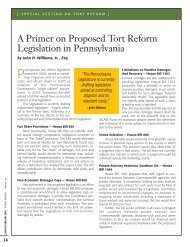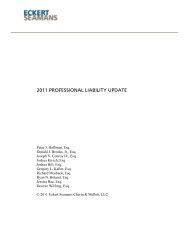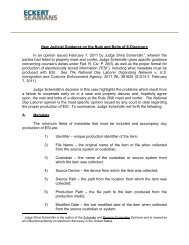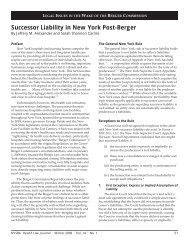certainty, the court reviews expert testimony in its entirety. Id. at 1030. “That an expert mayhave used less definite language does not render his entire opinion speculative if at some timeduring his testimony he expressed his opinion with reasonable certainty.” Carrozza v.Greenbaum, 866 A.2d 369, 379 (Pa. Super. Ct. 2004), affirmed, 916 A.2d 553 (Pa. 2007).In Winschel v. Jain, 925 A.2d 782 (Pa. Super. Ct. 2007), appeal denied, Winschel v. Jain,596 Pa. 709 (Pa. 2008), the Superior Court granted a new trial on the basis that the jury’sconclusion that Defendant’s negligence was not a factual cause of death bore no rationalrelationship to the undisputed evidence. The court also held that the trial court did not err inexcluding defense expert’s testimony in which he testified that an alternate cause might havebeen responsible for the harm, but never stated this opinion with the required degree of medicalcertainty.Note, however, that this aspect of the Winschel court’s ruling ignores the well acceptedrule stated in Neal by Neal v. Lu, 530 A.2d 103, 109-110 (Pa. Super. Ct. 1987), that a defenseexpert is not required to testify to a reasonable degree of medical certainty because the defendantdoes not bear the burden of proof. The court stated:Absent an affirmative defense or a counterclaim, the defendant's case is usuallynothing more than an attempt to rebut or discredit the plaintiff's case. Evidencethat rebuts or discredits is not necessarily proof. It simply vitiates the effect ofopposing evidence. Expert opinion evidence, such as that offered by [thedefendant] in this case, certainly affords an effective means of rebutting contraryexpert opinion evidence, even if the expert rebuttal would not qualify as proof. Ingeneral, the admission or rejection of rebuttal evidence is within the sounddiscretion of the trial judge.Id. at 110. This same well accepted rule is stated in the 2007 Superior Court case, Jacobs v.Chatwani, 922 A.2d 950, 961 (Pa. Super. Ct. 2007): “Pennsylvania law does not require adefense expert in a medical malpractice case to state his or her opinion to the same degree ofmedical certainty applied to the plaintiff, who bears the burden of proof at trial.” Id. (citing Nealby Neal v. Lu, 530 A.2d at 110). The Jacobs opinion was filed approximately two weeks beforethe Superior Court issued its opinion in Winschel.More recently, in Griffin v. University of Pittsburgh Medical Center-Braddock Hospital,950 A.2d 996 (Pa. Super. Ct. 2008), the Superior Court held that an expert opinion merely usingthe words, “within a reasonable degree of medical certainty,” by itself is not enough to meet therequirements for admissible expert testimony. In Griffin, Plaintiff was admitted as a patient atDefendant’s healthcare facility. Exploratory laparotomy and ileocolectomy were performed torelieve Plaintiff’s abdominal discomfort. Post-operatively, Plaintiff began to complain of rightshoulder pain. She was diagnosed with a shoulder fracture/dislocation which required extensivemedical care to treat. Plaintiff brought suit against Defendant claiming negligence.The main issue at trial was whether Plaintiff’s injury occurred as a result of a grand malseizure or from forcible restraint. The expert for Plaintiff opined that he was fifty-one percentcertain that the injury resulted from a restraint, and in turn, he was forty-nine percent certain thatthe injury resulted from a grand mal seizure. The jury ultimately returned a verdict in favor of44
Plaintiff. Defendant appealed that determination to the Superior Court based on the experttestimony provided on behalf of Plaintiff. The Superior Court held that “a ‘51%’ degree ofcertainty, was akin to an opinion stated to a ‘more likely than not’ degree of certainty, which islegally insufficient.” Id. at 1003. The Superior Court went on to further state that “despite Dr.Speer’s use of any so-called ‘magic words,’ the substance and totality of his testimony did notsupport the proposition, to the legally requisite degree of certainty, that forcible restraint causedMs. Griffin’s shoulder injury.” Id.2. Increased Risk of HarmIt is settled law in Pennsylvania that a plaintiff must establish that his injuries wereproximately caused by the acts or omissions of his physician in order to set forth a case ofmedical malpractice. See Hamil v. Bashline, 392 A.2d 1280, 1284 (Pa. 1978). Under Hamil,Pennsylvania courts recognized a reduced standard of —increased risk of harm—under certaincircumstances such as delay in diagnosis, testing or treatment resulting in a higher risk of harmto the patient.Under Section 323(a) of the Restatement (Second) of Torts (1965), a plaintiff has theburden of proof to establish:1. that the physician deviated from the standard of care;2. that the deviation increased the risk of harm to the patient; and3. that the harm in fact occurred.See Mitzelfelt v. Kamrin, 584 A.2d 888 (Pa. 1990). Under Pennsylvania law, it is not sufficientto state that a deviation might have or probably increased the risk of harm; rather, the medicaltestimony must establish to a reasonable degree of medical certainty that the deviation didincrease the risk of harm. See Jones v. Montefiore Hosp., 431 A.2d 920 (Pa. 1981).Only after a plaintiff first establishes competent medical expert testimony to supportthese foundation elements to a reasonable degree of medical certainty is the case permitted to goto the fact finder for a causal determination of whether the harm in fact resulted from theincreased risk. See Hamil, 392 A.2d 1280. Expert testimony on the second stage of an increasedrisk of harm case—the relaxed causation stage—allows an expert to testify that the increased riskmay have caused the harm. See Id.In Hankey v. York County Prison, No. 3:05-CV-0136, 2009 WL 2043392 (M.D. Pa. July8, 2009), Plaintiff brought suit under Pennsylvania medical malpractice law and under § 1983.Ryan Rorhbaugh, deceased, was substituted by Jessica Hankey as Plaintiff following his deathon June 7, 2006. Rorhbaugh was incarcerated at several facilities that used third-party healthcare providers. During Rorhbaugh’s incarceration, he was diagnosed with malignant melanoma.Plaintiff brought claims against the third-party providers, and several of their employees in theUnited States District Court for the Middle District of Pennsylvania. In response, the Defendantsfiled motions for summary judgment.45
- Page 3 and 4: EMTALA CASES ......................
- Page 5: Filing an Affidavit of Non-Involvem
- Page 8 and 9: II.PROFESSIONAL LIABILITY - AN OVER
- Page 10 and 11: The Superior Court reversed the tri
- Page 12 and 13: to a third party pursuant to the st
- Page 14 and 15: After approximately five months, De
- Page 16 and 17: learned the day after the surgery t
- Page 18 and 19: conduct to the delay in colon cance
- Page 20 and 21: court admitted the expert’s testi
- Page 22 and 23: (b)(c)other reasonable causes, incl
- Page 24 and 25: corroborated his testimony. The cou
- Page 26 and 27: husband’s estate. Plaintiff alleg
- Page 28 and 29: Other notable federal cases arising
- Page 30 and 31: The Superior Court found that in re
- Page 32 and 33: § 1303.512(b). The court, however,
- Page 34 and 35: In Neidig v. United States, No. 07-
- Page 36 and 37: Additionally, the Supreme Court not
- Page 38 and 39: were not indicated for her conditio
- Page 40 and 41: surgeon is the same as it would be
- Page 42 and 43: It should be noted that the Superio
- Page 44 and 45: Finally, the court held that the tr
- Page 46 and 47: The Supreme Court of Pennsylvania r
- Page 48 and 49: nurses deviating from applicable st
- Page 52 and 53: Under Pennsylvania law, the Court n
- Page 54 and 55: testimony, Defendant presented his
- Page 56 and 57: Following Cooper v. Roberts, 286 A.
- Page 58 and 59: Plaintiff developed chronic diarrhe
- Page 60 and 61: where payment is made by Medicaid w
- Page 62 and 63: accomplished. In Valles v. Albert E
- Page 64 and 65: In 1980, the Pennsylvania Superior
- Page 66 and 67: Plaintiff had a routine monitoring
- Page 68 and 69: Plaintiff’s Contract ClaimsThe Co
- Page 70 and 71: is a failure to report changes in a
- Page 72 and 73: unit to assure post-surgical patien
- Page 74 and 75: sliced his wrist and arm with a raz
- Page 76 and 77: licensed professionals for whom the
- Page 78 and 79: (c)Limitations of Corporate Neglige
- Page 80 and 81: Even more recently, our Superior Co
- Page 82 and 83: (a)HMO IssuesIn McClellan v. Health
- Page 84 and 85: affidavit submitted by Defendants o
- Page 86 and 87: treatments while at VA’s faciliti
- Page 88 and 89: [s]ubstantively, we believe that a
- Page 90 and 91: The party claiming the benefit of t
- Page 92 and 93: deprive (him) of civil rights guara
- Page 94 and 95: found that the District Court was w
- Page 96 and 97: With respect to fraudulent concealm
- Page 98 and 99: would be applied in situations wher
- Page 100 and 101:
they had not raised them in the cou
- Page 102 and 103:
(a)Informed ConsentUnder MCARE, a p
- Page 104 and 105:
civil enforcement provisions and ma
- Page 106 and 107:
MCARE also changes the manner in wh
- Page 108 and 109:
whose death, in 2005, was allegedly
- Page 110 and 111:
vicariously liable if the plaintiff
- Page 112 and 113:
health center or its equivalent or
- Page 114 and 115:
In Pennsylvania Medical Society, th
- Page 116 and 117:
to any professional who is alleged
- Page 118 and 119:
Since the 2005 amendments, there ha
- Page 120 and 121:
ule, but who intentionally ignores
- Page 122 and 123:
the original Complaint was delivere
- Page 124 and 125:
foreclose all challenges against th
- Page 126 and 127:
number of boxes), which was support
- Page 128 and 129:
questions of professional judgment
- Page 130 and 131:
deviated from any professional stan
- Page 132 and 133:
The Third Circuit affirmed the Dist
- Page 134 and 135:
claims and cross-claims remain agai
- Page 136 and 137:
By an Amendatory Order dated March
- Page 138 and 139:
The court acknowledged that there i
- Page 140 and 141:
apply and that the trial court misa
- Page 142 and 143:
Barbados had enough litigation-spec
- Page 144 and 145:
E. Preemption of Vaccine Design Def
- Page 146 and 147:
2. Pa. R. Civ. Pro. 1036.1 - Reinst
- Page 148 and 149:
Barrick, at *34-35.Furthermore, the
- Page 150 and 151:
(b) the utility of the defendant’
- Page 152 and 153:
2006). In this case, Plaintiffs bro
- Page 154 and 155:
B. Elements of a Cause of Action fo
- Page 156 and 157:
decision in Muhammad precluded Mr.
- Page 158 and 159:
considered speculative “only if t
- Page 160 and 161:
underlying cause of action involved
- Page 162 and 163:
In Capital Care Corp., the Superior
- Page 164 and 165:
The court found, however, to state
- Page 166 and 167:
of reasonable diligence. The standa
- Page 168 and 169:
not be set aside. On July 7, 2005,
- Page 170 and 171:
complete bar to recovery. Since a l
- Page 172 and 173:
On appeal, Plaintiffs claimed that
- Page 174 and 175:
In Liggon-Redding, 659 F.3d at 265,
- Page 176 and 177:
elieved of those minimum standards
- Page 178 and 179:
elevant to the proceedings, the com
- Page 180 and 181:
establish professional misconduct b
- Page 182 and 183:
Upholding the Superior Court’s Or
- Page 184 and 185:
Id.Rejecting revocation and suspens
- Page 186 and 187:
order as a sanction under Rule 4019
- Page 188:
{1009912]182









